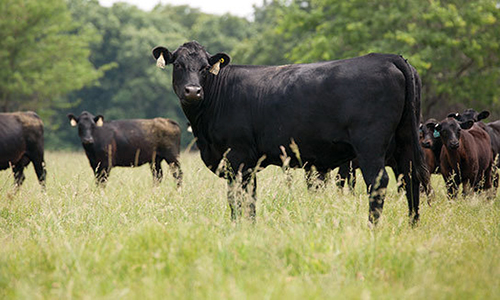The summer slump in cool-season grass growth got a knockout punch from heavy rains in July across much of Missouri.
Good growth for most grasses won’t be good for toxic tall fescue pastures, says Craig Roberts, University of Missouri Extension forage specialist.
“Keep your eyes open,” Roberts tells cow herd owners. “The rapid grass growth makes more toxin in fescue leaves.”
Toxic tall fescue adds to heat stress in cattle. That comes at a time of high-temperature forecasts. “Stress becomes a double whammy. The toxin in the grass adds to ambient temperatures,” Roberts says. “Hot weather arrives when cattle can’t deal with it.”
Most years, grass pastures are heading into a low-growth phase by mid-July. Seasonal growth patterns and dry weather team up to slow growth—and grazing.
Not this year.
By mid-month this year, July already set records for rainfall in many areas. Heavy rains and mild nighttime temperatures bring robust grass growth.
Usually, by mid-July farmers move livestock to warm-season grasses, which keep growing. But, more importantly, warm-season grasses contain no toxins.
This year, livestock producers must watch their livestock for heat stress when cattle graze fescue, Roberts says.
A major side effect of toxic fescue is heat stress. Ergovaline, the toxin produced by fungus growing within the fescue leaves, constricts blood vessels. That reduces blood flow, preventing cattle from cooling.
Pregnant cows with heat stress are at risk. They stop grazing to head to a pond or shade trees to cool off. Reduced grazing time cuts growth.
If cattle show stress, take them off toxic fescue, Roberts says.
Earlier, MU Extension forage specialist Rob Kallenbach alerted producers to not delay on moving cattle to the warm-season grasses. Delayed grazing lowers quality when those grasses mature.
Shoulder-high switch grass that sets seed heads has the grazing quality of straw, he warned.
Toxic tall fescue has many other side effects besides heat stress, Roberts says. Ergovaline cuts milk production in beef cows with unweaned calves.
Calves don’t gain as well on the fescue as they learn to graze forages while still nursing.
The best cure for toxic fescue is replacement with a new fescue variety with a novel-endophyte fungus. Novel-endophyte fescue has all the advantages of fescue’s superior growth, but without the side effects.
Toxic Kentucky 31 tall fescue is the most widely grown grass in Missouri.
In addition to its harmful side effects, the fescue fungus adds to the plant’s hardiness. The new fescue varieties have an endophyte, but not the toxin.







